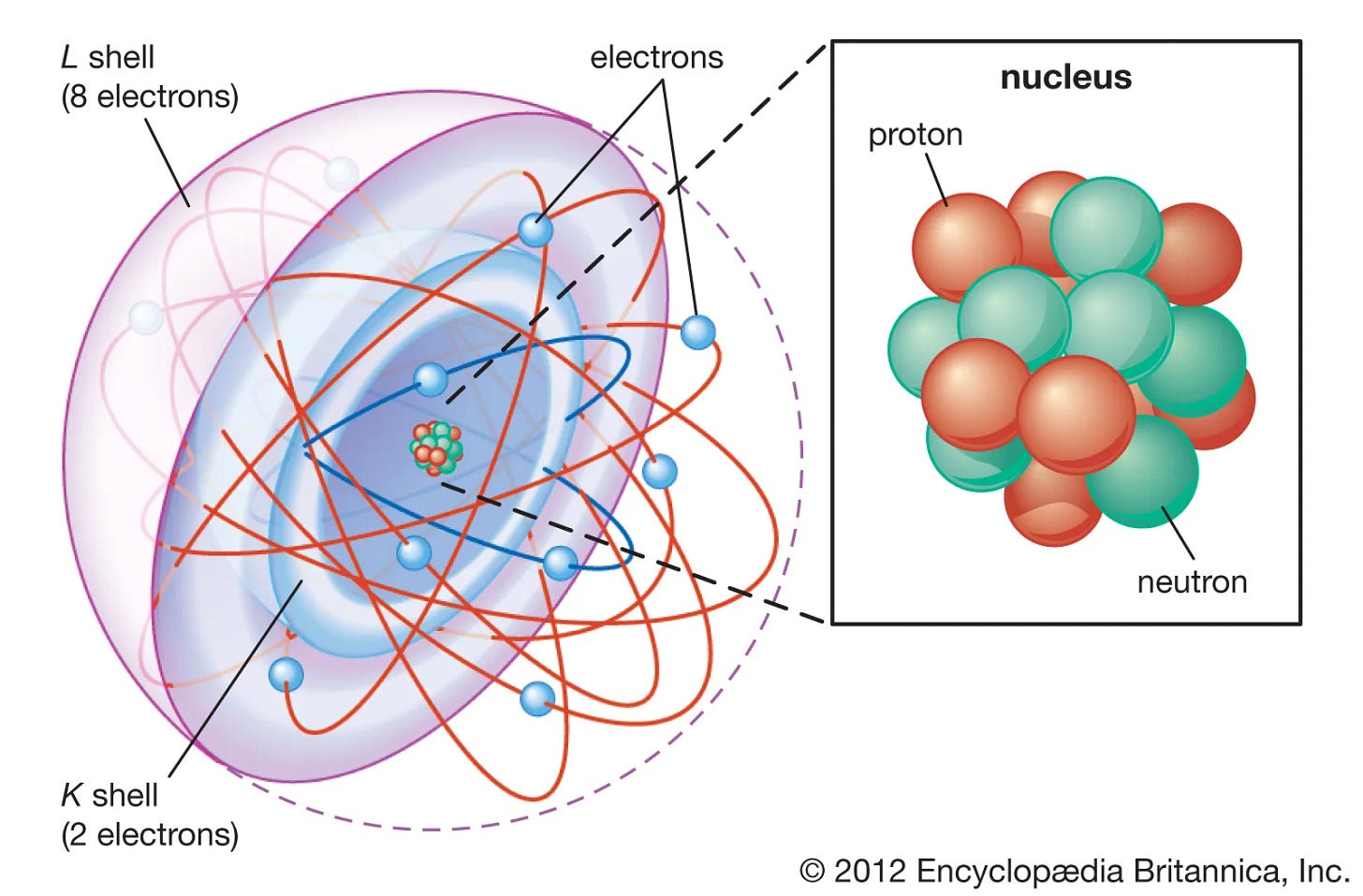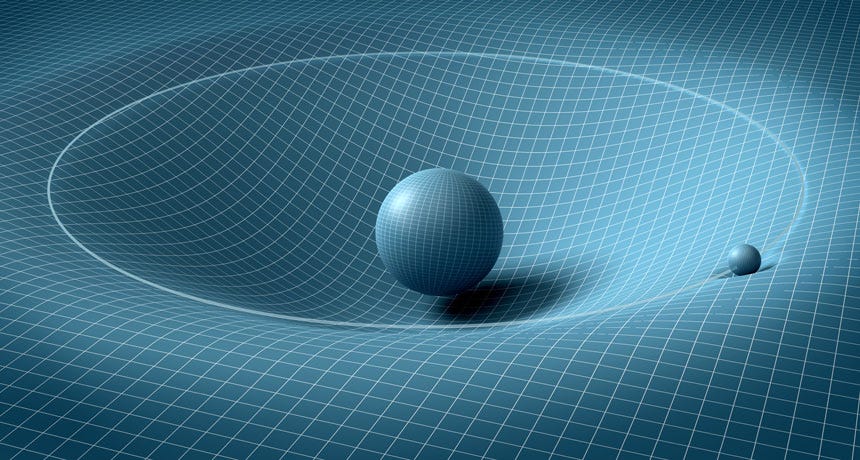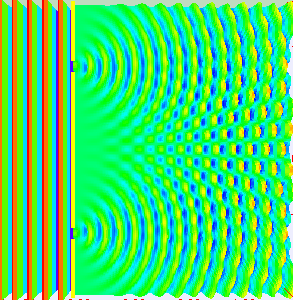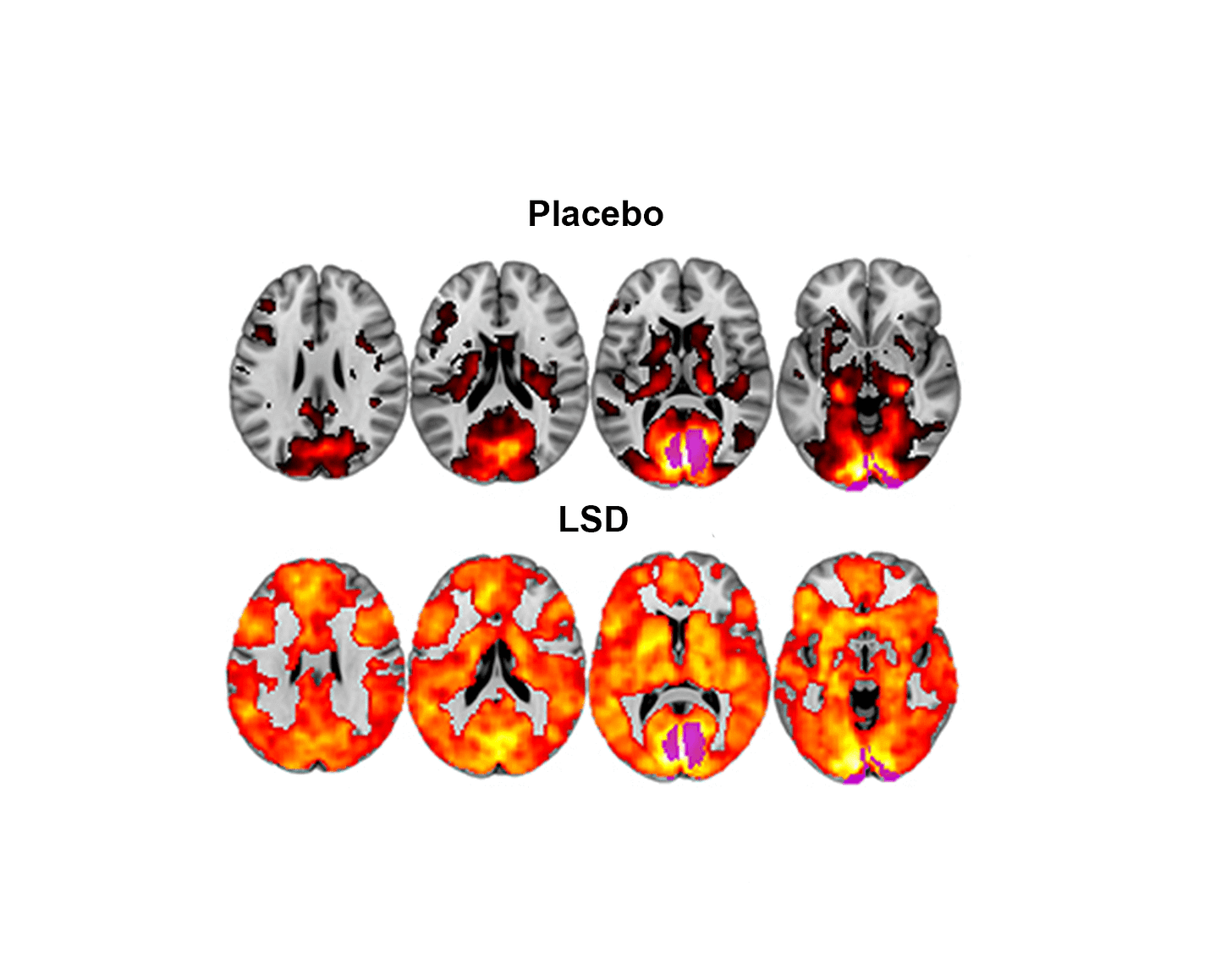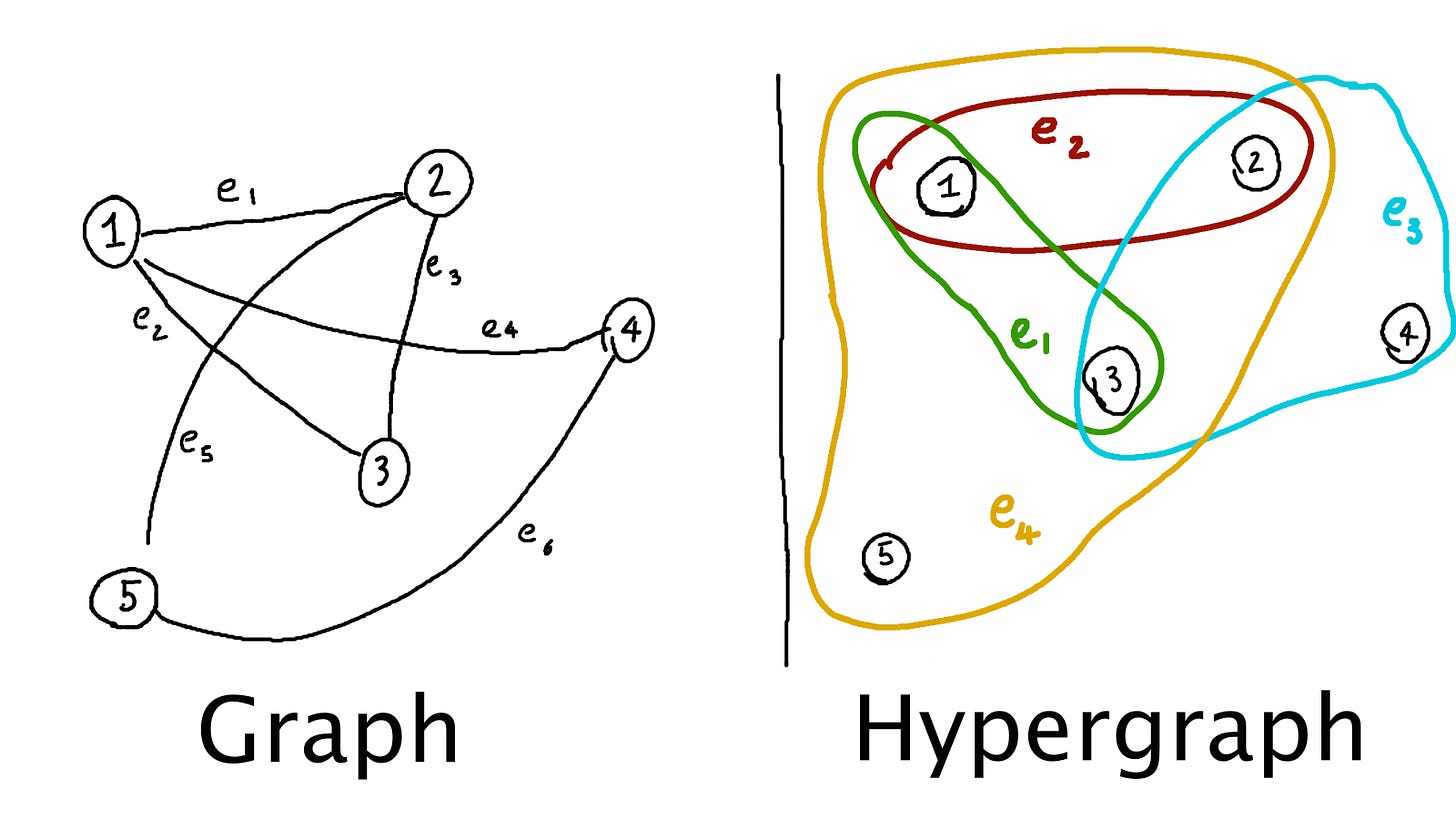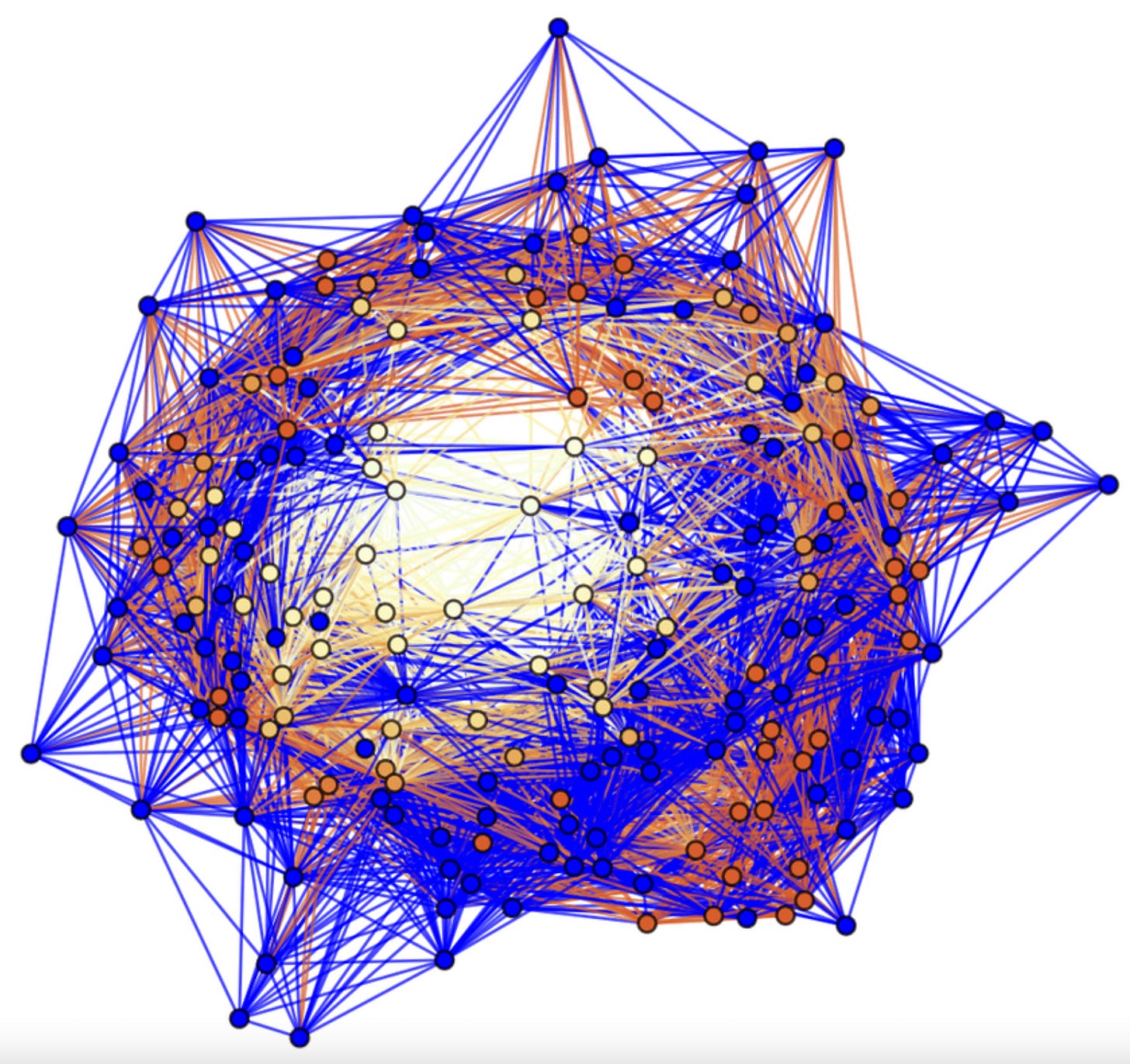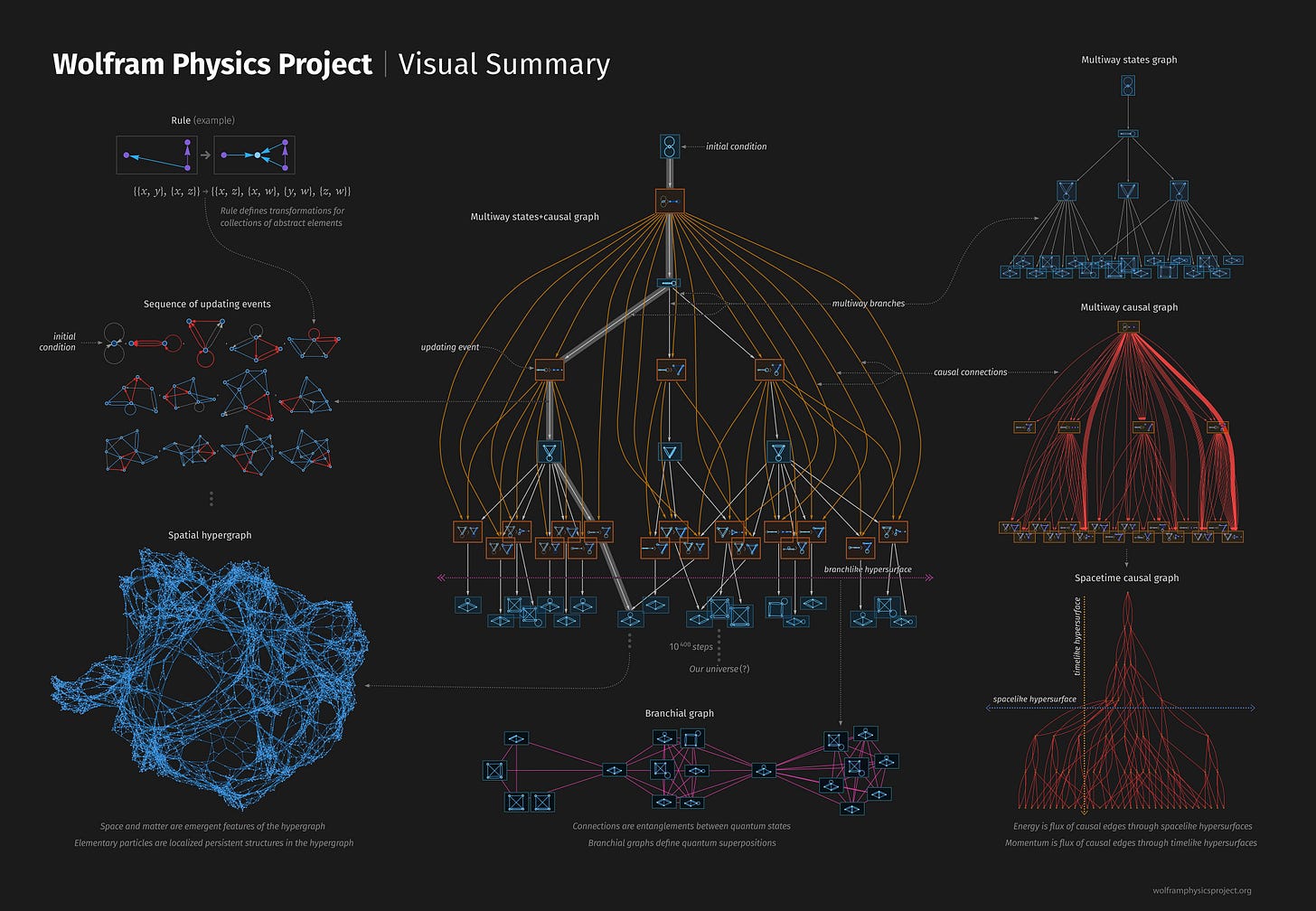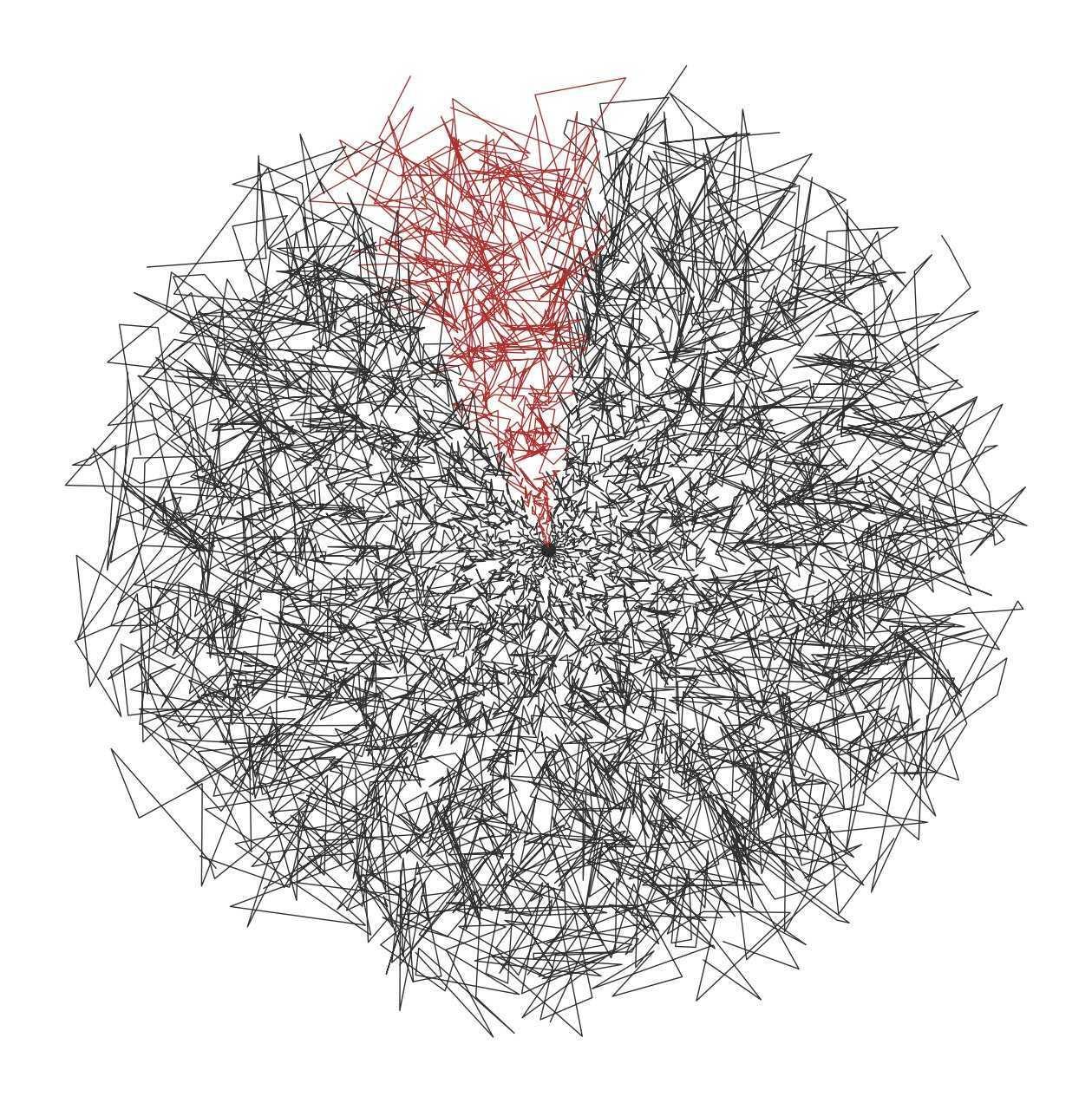Why these physics principles and not others?
It’s a question that’s plagued me for a long time. Like, seriously, think about the layers of it.
Why this set of physics principles and not others?
There’s an obvious answer at a superficial level, which is: classical physics, ya dummy! To which I’d agree with at that level! Except, that’s not the full story and hasn’t been the full story for over a century.
In this post, we’re venturing Beyond the Yellow Woods on this very topic. We’re going to cover all sorts of weird shit, including “WTF is all of this!??”. It’s a fun rabbit hole. It has no end that I can personally see. It’s a sort of existential crisis of understanding this that, at the end of the day, there isn’t really anything we can do about it. But, nonetheless, I find myself thinking about it more and more - especially as I watch my daughter grow up. So, we’re going to take a path less beaten and see where we end up. Enjoy!
For me, this journey down the rabbit hole started in late elementary school. My parents had gotten divorced when I was in 4th grade and I ended up spending a lot more time with them individually for longer stints. My Dad was obviously going through some shit at the time and we’d spend many hours, late into the night, shooting pool and eating pizza. Once we’d wrap up, we’d head home and that’s when the fun started.
See, my Dad is a pretty smart guy. He’s a geneticist by trade but is a brainiac for all the things. He’s naturally curious about the “edge” of science in most fields. One particularly fond memory I have was coming home from the pool hall and my Dad cooking up some super shitty garlic bread from Walmart and rolling out a gigantic genetic map of the mouse genome. He was a professor for some time and so he defaulted into that “mode” and would just ramble on and on about the different genes, their role, proteins produced, common variants for important genes, etc. For a little old 5th grader, it was particularly fascinating.
On that night, my dad made a comment that has stuck with me for a long time that was something like this:
Genetics is just an inredibly complex programming language - programming language for biology.
And he’s not wrong. In computer science, we have bits that get interpreted as 0 or 1 in binary. Oversimplifying here but, conceptually, you get the picture. We then have bytes which are groupings of 8-bits that help systems handle bits more efficiently. From there, we have the standard kilobytes, megabytes, etc. It’s just layers of groupings and abstractions to help the “computer” more efficiently do a thing.
In genetics, we see similar concepts but incredibly more complicated. At the base level of DNA, we have Adenine, Thymine, Cytosine, and Guanine which we call nucleotides. Nucleotides are essentially biology’s “0s and 1s”.
When you group 3 nucleotides together, you get a codon. Codons determine the sequence in which amino acids are assembled to create proteins through a complex process that involves tRNA and ribosomes.
Codons make up genes. Genes make up chromosomes. Chromosomes make up a genome.
I’m glossing over billions of years of nature’s experimental design but you can get the concept I’m trying to convey: both computers and biology have a sort of base programming language with many layers of logic, interpretation, and abstraction built on top of them to make up what we experience.
That’s all super cool and whatever but we haven’t started to answer the question of “Why this set of physics principles and not another?”. So, let’s keep going.
Nucleotides are just a molecular formula. For example, Adenine is made up of C₅H₅N₅.
Breaking down the molecules, we see the following:
Carbon (C): 5 carbon atoms.
Hydrogen (H): 5 hydrogen atoms.
Nitrogen (N): 5 nitrogen atoms.
Ah… now we’re getting close to classical physics. Atoms! But wait, how do these atoms that create C₅H₅N₅ get formed? Like, what causes them to group together such that there is a thing called “Adenine”? How does carbon get 5 carbon atoms?
Well, before we get Adenine, we have to create it through a series of enzymatic reactions within a cell. This is called “Adenine Synthesis”.
I’m dramatically simplifying here but this is what the process looks like:
Starting Material: There’s a precursor molecule called 5-phosphoribosyl-1-pyrophosphate (PRPP). This is formed from ribose-5-phosphate which is derived from glucose through a nifty molecular pathway called pentose phosphate pathway.
Initial Steps: The amino acid glutamine donates an amino group to PRPP through a reaction catalyzed by the enzyme PRPP amidotransferase, which formulates 5-phosphoribosylamine.
Incorporation of Carbon and Nitrogen Atoms: Now, over several additional steps, atoms from various sources like glycine, formate, and carbon dioxide are added through chemical reactions. This forms an intermediate molecule called inosine monophosphate (IMP).
Conversion of IMP to Adenine Nucleotide: IMP can be converted to adenosine monophosphate (AMP), a nucleotide that contains adenine as its base. This is a two-step process:
IMP is first converted to adenylosuccinate by the addition of an aspartate amino group in a reaction that requires GTP as an energy source.
Adenylosuccinate is then cleaved to form AMP and fumarate.
Ok, yeah a little too deep.
Anyway, the point here is that some shit happens, there’s a melting pot of stuff, they play nicely with each other in weird ways, and out pops a thing called Adenine through a process called Adenine Synthesis which is governed and controlled within the cells of your body. For a sense of scale, the size of a nucleotide is around 3.3nm. We’re talking super small shit right now.
But WAIT. We still haven’t really answered the damn question yet! So we must go deeper. So, each of these molecular elements, such as carbon or hydrogen, is composed of atoms. Atoms are what make the world go around and are what make the basis for “reality”. Right?
Ok well an atom, at its core, is made up of protons, electrons, and neutrons. Protons are positively charged particles that live at the center of atoms. Electrons are negatively charged particles that orbit the center of the atom. Neutrons are neutral charge (no charge) and are found at the center of an atom.
Not all atoms are created equal so in order to determine the different types of atoms, we have Atomic Numbers. For example, atoms with just 1 proton are all hydrogen atoms while those with 6 protons are all carbon atoms. To form chemical bonds and whatnot, atoms can interact with each other through sharing or transferring electrons with other atoms, creating bonds such as covalent or metallic bonds.
So, that’s all chill. We’ve got these little circle-floating things that have particles in them and when they interact with each other, shit happens which creates a physical reality. This happens everywhere, all the time.
But wait, we used the terms “center” and “orbit” which means that atoms have some sort of dimension that is defined by gravity or something, right? Otherwise, the electrons and protons would just fly off into nothingness.
Alright, now we’re starting to answer the question.
Within atoms, we have a thing called electromagnetic force. Electromagnetic force is considered one of the fundamental forces of nature. The other forces are gravity, strong nuclear force, and weak nuclear force. The 4 of these essentially govern the reality that we experience since they are what allow atoms to stay intact. James Clerk Maxwell created a set of equations known as The Maxwell Equations. I won’t list them all here, but if you want to go next-level nerdy, check out the Wikipedia page.
To briefly summarize these equations:
Gauss’s Law of Electricity: The more electric charge you have in a thing, the stronger the electric field coming out of it will be.
Gauss’s Law for Magnetism: There are no north or south poles in isolation; they always come in pairs (you can’t have a north without a south).
Faraday’s Law of Induction: There’s a dance floor where the lights change based on how people move. If people start dancing faster (changing the magnetic field), the lights (electric field) will change too. This equation says that if the magnetic field changes, it creates an electric field.
Ampere’s Law with Maxwell’s Addition: Picture a musical band. The louder the instruments play (electric current), the stronger the music vibes (magnetic field) they produce. But there's also a singer (Maxwell's addition) who can add to the vibes even if they aren't playing an instrument. This equation tells us that both electric currents and changing electric fields can create magnetic vibes.
Take special note of “magnetic fields” and “magnetic vibes”. We’ll be coming back to those concepts later.
Alright, we’ve now got some super basic ground covered on subatomic mechanics. What we’ve basically got here is the demarcation line between the set of physics principles that create the reality we experience and “other” sets of physics principles.
We have Maxwell’s Equations that “create” and structure atoms, which produce molecular chemistry, which produce nucleotides, which produce codons, which produce genes, which produce chromosomes, which produce genomes, which are what makes us, us.
One gigantic, absurdly complicated programming language. If we were in a video game, what we’ve covered so far is the “game engine”, so to speak. The game engine defines the base level of what a character can experience, which we call “reality”.
At this point, it’s worth noting that not all things in this reality are experienced the same way. For example, dogs don’t experience smell in synthesis but rather smell the individual ingredients separately. Another example is birds and how their vision experiences a different spectrum of color relative to humans. This is not all to say that the set of physics principles that they operate off of is different but rather that their experience is different in the physical form.
It’s at this point that we should talk about time. Time is a fundamental constant that humans experience. Second by second, motion by motion, and always there. A fundamental truth that is constant and non-changing.
Except, not really. #thankseinstein
Albert Einstein discovered a couple of stupid important truths that further rock the foundation of what “reality” is. These are Special Relativity and General Relativity. Using our handy-dandy ChatGPT, here’s what it spits out when asked to explain like I’m an idiot:
Special Relativity: Imagine you're in a super-fast spaceship that can zoom close to the speed of light. If you have a flashlight and turn it on, the light from it will always rush away from you at the same speed, no matter how fast you're going. That's weird because if you throw a ball in a moving car, its speed changes depending on the car's speed. But light doesn't work like that. It always goes the same speed. Because of this, some strange things can happen:
Stretchy Time: If you were in your fast spaceship and looked at a clock inside with you, it would seem normal. But if someone outside the spaceship watched your clock, they would think it's ticking super slow. So, when you zoom around in space and come back, you might be a little younger than your friend who stayed home.
Shrinking Spaceships: If someone outside looked at your spaceship when it's going really fast, it would look shorter to them! But inside, everything would seem perfectly normal to you.
General Relativity: Now, think of space like a big stretchy trampoline. When you put something heavy on it, like a bowling ball, it makes a deep dip. If you then roll a marble near the bowling ball, the marble will roll around the dip, like it's being pulled toward the bowling ball. Space works similarly:
Stretchy Spacetime: Big things like planets, stars, and black holes "dent" space, like the bowling ball dents the trampoline. This is gravity! When smaller things, like spaceships or moons, get close, they move along these dents.
Time Goes Slow Near Heavy Things: Just like our super-fast spaceship made time stretchy, heavy things can too. If you lived right next to a supermassive black hole (but didn't fall in), time would go slower for you than for someone far away. So after a while, you'd be younger than your friend who lived on a distant planet.
So, everything is all relative. Now, this doesn’t really impact us on a day-to-day basis because even Usain Bolt can’t run as fast as a photon, but it is extremely important when it comes to breaking down this “game engine” that we live in.
Time is not a constant. We perceive it as being a constant. In fact, a photon moving at the speed of light can be manipulated. We’ve been able to slow, stop, and restart light for over 20 years now, breaking down the notion of the speed of light being a constant.
So the fundamental constants that we’ve believed to be constants are no longer constants. We’re now starting to see a different set of game engine rules.
Back to the main question. We know that constants are no longer constants. We know that atoms are the foundational building blocks of what we “experience” in reality. But we haven’t explored the subatomic realm of an atom yet.
And this, my friends, is where the real fuckery starts to bend the mind.
Let’s talk about quantum physics.
Once again, I was blessed (or cursed) to be exposed to quantum physics at a young age. In 7th grade, my Dad and I had come home from a late night at the pool hall. He was in a particularly chatty mood and we happened to have a whiteboard in his home office. One thing led to another and over some shitty Walmart pizza, he drew out the theory of relativity for me.
A bit shocking but I was young so it’s not like I really grok the depth or gravity of what he was saying (no pun intended). However, this led us down the conversational path of broader physics and “fallacies” of reality. That’s when he dropped the bomb of quantum physics on me which landed. Naturally, I went through an existential crisis phase asking all sorts of questions about the nature of reality, so much so that I was actually sent to the counselor’s office at my junior high school for a “wellness” checkup because I was arguing with teachers that what we experienced just an illusion.
In classical physics, an atom has a proton, electron, and neutron. As we covered already, there are forces that keep these subatomic particles in an orbit along with classical mechanics for bonding atoms together.
Let’s talk about a famous experiment: The Double-Slit Experiment.
Imagine you have a wall with two narrow slits (like small doorways) and another wall behind it. Now, you start throwing tennis balls at the first wall.
Tennis Balls (Classical Idea):
When you close one slit and throw tennis balls, they'll either pass through the open slit or hit the wall and bounce off. You'd see marks on the back wall only where balls passed through the open slit.
If both slits are open, you'd expect to see two bands of marks on the back wall, each behind one of the slits.
Now, let's replace tennis balls with something much smaller, like electrons (tiny particles).
Electrons (Quantum Magic):
If you send electrons with one slit closed, they'll behave just like tennis balls. You'll get a band of hits on the back wall behind the open slit.
But the magic happens when both slits are open. Instead of just two bands of hits like with tennis balls, you see a pattern of several bands, like stripes. This is the kind of pattern you'd expect if waves (like water waves) were passing through the slits and interfering with each other.
WAT? You’re telling me that a single object, when 2 slits are open, becomes a wave?
The Real Magic (Observation): If you decide to peek and set up a detector to see which slit the electron goes through, the electrons stop acting like waves and go back to acting like tennis balls, giving you just two bands.
This suggests that just by watching (or measuring), we change how the electrons behave. It's as if the electrons "know" they're being watched.
Now, really think about this for a second. The above applies to all subatomic particles - the thing that makes an atom… an atom. The subatomic particles that make up an atom do not exist until they have been observed by a thing.
Normally, I’d take the next assertion and say that it is being “observed” by something that is conscious, so consciousness is what creates a classical state in the double-slit experiment (more technically known as quantum decoherence). An observer is said to collapse the wavefunction of a quantum state.
But, this isn’t the case as we’ve learned a lot about the ranges of what qualifies as an observer. Just saying “consciousness” is a very human-outward-projected mindset, essentially positioning the belief that humans have a unique, intrinsic thing about them that causes the wavefunction collapse. However, we know that non-conscious things, such as the environment or Geiger counters, can collapse the wavefunction.
So, we’re still back to the question of what, exactly, creates these sets of physics principles and not others.
No. One. Knows. Seriously, we all have theories about this stuff but no one actually knows. Some may lean on the concept of a “god” - a higher-order being - while others take a more existential approach (we live to die and that’s it).
This is where we must lean on a combination of philosophy and theoretical math/physics. I may even go as far as to say that we need to include religion or spiritualism in this quest because the rabbit hole just keeps going deeper.
Inside our skulls is a giant, incredibly complex grey thing called the brain. This is where I think our journey starts.
The connectome of the brain is the complete map of neural connections in nervous systems. The thing about nervous systems is that they are what “create” - or rather measure - our 5 senses. It’s what locks our eyes into seeing and interpreting visuals in a 380 to 700-nanometer UV spectrum.
The nervous system is interwoven throughout our entire body, providing environmental feedback, with synthesis, that creates this reality. But, from what we’ve already talked about, that reality is nothing more than the quantum state collapsing into a classical state. From that perspective, the nervous system is what roots us in this reality (or perhaps entraps us in it).
This is where you’re going to need to take a little leap in suspending your prior beliefs with regard to what I’m going next.
And the reason for that is because we’re going to talk about hallucinogenics.
The connectome is something that, quite literally, gets more rigid over time. It’s why kids are so efficient at learning and why you “lose it” if you don’t use it over time. The brain atrophies to fire along the same pathways, creating the same mindsets, behaviors, addictions, etc. However, have you ever seen an fMRI of a brain on a hallucinogenic vs. a placebo?
Now, we’ll be actually looking at some other specific hallucinogenics but the above example is an image of a placebo brain vs. a brain on LSD. The staggering amount of additional neural activity within the entire connectome is mind-blowing (almost literally). What we have found in research is that certain classes of hallucinogenics dramatically impact something called the “transmodal association cortex pole” within the brain.
The transmodal association cortex pole can be thought of as a part of the cerebral cortex that is involved in high-level cognitive processing, integrating and abstracting information from various sensory inputs to facilitate complex mental functions. This region is critical for the kind of abstract thinking and reasoning that characterizes human cognition
There was an extensive study done that focused on the neural activity and connectome changes that occurred while the brain was on DMT which, by the way, is a naturally occurring chemical in the human body. There were many findings from the study but one that stood out to me was that the typical segregation of neural activity between the different regions of the brain was decreased substantially. Meaning, that the cross-regions of the brain are communicating at a much, much higher bandwidth and spectrum than in a placebo state.
At a lower level, what is happening in the brain has an N increase in neuron-to-neuron neurotransmission and signaling cadence. Neurotransmission is performed by neurotransmitting chemicals, such as peptides, glycine, etc. Well, taking glycine, for example, the chemical compound is simply C2H5NO2. I see our good ol’ friend's carbon and nitrogen in there, so now we’re back to the same section in this article around genetics.
These chemicals only exist because their subatomic particles have been “observed” and their wavefunctions have collapsed, rendering the reality that we experience. How does this tie in with the brain on DMT?
What’s essentially happening is that there is an N number of new cross-brain neural pathways signaling to each other within the connectome. The synthesis of these new signaling pathways creates the classically described psychedelic experience. These experiences are described as complete “out of body” experiences, where there is no “body’ to ground one’s mind yet the mind is fully intact to the show that happens. And that show is a spectacularly consistent one, with people consistently describing that they “feel the vibrational energy of everything” and often “see the light” which has been attributed to the idea of the feeling of a “god”.
In clinical settings, the majority of patients that go through this experience, regardless of religious alignment, come out of the experience describing it as “the most important/impactful experience of their life”. They describe being able to communicate visually and that the broad spectrum of their senses was transformed with their mind/soul/spirit being marshaled across multiple dimensions.
These patients experience all-encompassing, full-blown visual hallucinations with many describing seeing mathematical patterns of being able to visually sense the energy vibrations of the things the experienced during the experience. However, it is consistently and objectively not what we experience in “our” base reality.
That last sentence is very important based on what we’ve talked about so far in this article. The brain is firing in completely new ways in different cadences, such so that the realm of reality is not longer “real” as far as the mind is concerned. The mind is no longer constrained to classical physics, creating objects that we know. Like, we cannot visually see the image below:
Yet, for those in the experience, it is 100% objectively their reality. So, my theory here is that these hallucinogenics are able to collapse wavefunctions where the base level of physics principles is completely different. The new connectome neural activity synthesizes an entirely new reality because the concept of an “observer” is fundamentally different, pushing the origin of the “observer” somewhere in the brain but not constrained to the human body, as we already talked about the other ways of measurement for collapsing the wavefunction.
It’s almost like an alternate reality or being able to project the mind into a different dimension or dimension. But, a key description (although qualitative) is that people describe the experience as being able to feel the vibration of the things around them. The different energy states. (good energy, bad energy, etc.)
In the above picture, you can see in the center a white light. This is an incredibly common and consistent description with many describing the light as the most intense, all-encompassing, omnipresent, and “loving” light. Sort of like a higher order or heaven perhaps.
By now, I’m hopeful that all of us readers (myself included as I re-read this over and over) are realizing that we currently can’t answer the question of why these sets of physics principles and not others.
In my opinion, there is something going on within the brain that creates the properties of an observer that is able to experience this reality while simultaneously capable of rendering a “hallucinogenic” reality experience for the same sense in a completely different way while retaining the concept of “soul” or whatever - something that has a grounding property. People describe these experiences as still “conscious” and knowing who they are, so the “self” is there, suggesting that the self is something that is yet a different rabbit hole topic.
There is one theory that I keep coming back to as an interesting that could potentially help detangle this mess. But hey, it’s out there. It’s fringe. I get that. But fuck it! This newsletter is in the business of going down rabbit holes so let’s do it.
I’d like to introduce The Concept of a Ruliad.
The concept of a Ruliad is a mathematical theory proposed by Stephen Worlfram that attempts to create a unified theory of all the things. At the heart of the theory lies the idea that the entire universe and all its phenomena is a vast network of abstract computational processes. Layers of abstractions on top of layers of abstractions - similar to what we’ve discussed so far. These processes, or "rules," operate at a level more fundamental than particles and forces, generating the complexity and diversity observed in the physical world. The Ruliad is essentially the totality of these computational processes and their interactions. Another theory set that this plays off of is cellular automata.
One of the more critical aspects of the Ruliad theory is that we must operate on a set of computational irreducibility. We must start from the ground up and cannot take shortcuts, mainly because in order to determine a system as complex as ours, one must simulate the basis of the rules from the ground up to pressure test the theory. If we take shortcuts, we’re both making assumptions as well as creating predictive behavior which, when working on systems this complex, causes the end state to be led astray in spectacular fashion.
While I’m still trying to grok the theory as a whole, one of the more interesting concepts for me central to the theory is that it requires a spatial hypergraph, which is used to model the structure of “space”. Before the “spatial” description, let’s focus on a hypergraph. A hypergraph is a generalization of a graph in which edges can connect any number of nodes, not just two as in traditional graphs. This allows for a more complex and interconnected representation of relationships, which is key to modeling the intricate fabric of space.
When we add “spatial” to a hypergraph, we’re essentially adding dimensionality to the equation.
You get an incredibly complex, entangled web where edges of the graph can connect to any node, within the space that it presents itself. I first got some exposure to this concept when stumbling across topological data analysis (TDA). While the mathematical theories are not the same. TDA focuses on the shapes and topological features of data. It uses concepts like persistence homology to understand the structure of data across multiple scales and dimensions. Spatial hypergraphs, on the other hand, are Based on the idea of a network of nodes and edges, with edges potentially connecting multiple nodes. These hypergraphs are dynamic, evolving according to specified rules, and are intended to represent the very fabric of space-time.
Alas, I digress. Back to Ruliads and spatial hypergraphs.
Within the Ruliad theory, the nodes are what define the “space” of the spatial hypergraph. However, within the Ruliad, the hypergraph is dynamic and evolving based on the rules underpinning the hypergraph. These rules end up determining how nodes and edges are connected, added, removed, etc. This part of the theory is an attempt to explain the fundamental properties and behaviors observed in physics, such as particle interactions, gravity, and electromagnetism. The idea is that these physical phenomena emerge from the underlying computational processes of the hypergraph.
It’s at this junction that we start to touch on the quantum mechanics angle of all of this. The intention of the spatial hypergraph provide a framework to unify quantum mechanics and general relativity. Quantum phenomena arise from the superposition of different possible states of the hypergraph, while relativistic effects are a result of the large-scale structure and dynamics of the hypergraph. The spatial hypergraphs represent all possibilities of all rules within the limits of computational irreducibility.
Said differently, what we “observe” as reality is one of infinite collapsed quantum states within the spatial hypergraph. A collapsed state of a set of rules from many rules that generate this.
Oof. Headspin… Let’s look at an image to help ground some of this.
The above is the “map” to the principles of the Ruliad. In a nutshell, here’s a breakdown of each section of the map.
Rule: A rule transforms a network. This rule is symbolic and abstract, representing how elements (possibly representing fundamental particles or spacetime structure) can change over time. Think of this like a programming language of sorts.
Sequence of updating events: The initial condition evolves over time into increasingly complex networks, applying the transformative rules in iterations.
Spatial hypergraph: The spatial hypergraph representation suggests that space and matter are emergent features of a hypergraph. Elementary particles are described as localized structures within this hypergraph.
Multiway states graph: This graph shows possible states of the system branching out from an initial condition, reflecting the idea of multiple histories or parallel universes. A similar analog here is the electron in quantum coherence where it’s in all probabilistic positions as once until observed in 1 position.
While not a perfect representation of this, a visual I keep coming back to is this.
Multiway causal graph: Multiway causal graphs are networks that represent the causal relationships between different states as they evolve over time.
Branchial graph: Branchial graphs depict connections that symbolize quantum entanglements and superpositions, suggesting a networked view of quantum states.
The visual in the center of the image is the bringing the whole concept together. All of this exists within the concept of a “Ruliad”.
Now, some folks I know who are wayyyyy smarter than me think that the above is a crockpot full of shit that has no grounding. Purely theoretical and fringe, suggested by someone who doesn’t have credibility in the field. And that’s fine, I’m not going to be the one who determines that since I have zero credibility myself. I’m a nobody in this game.
But.
The theory is interesting to me nonetheless. It’s interesting to me because I can see how it maps to the reality that we experience today.
Now, taking a leap into the crazy here, but let’s go back to the concepts of the “observer” and hallucinogenics for a second.
When our brains light up in new ways and are firing off new connections within our connectome, one key element here is that the concept of “consciousness” is still present. Alcohol or other drugs create a sort of “blur” of the mind where gaps in memory of fuzziness occur. The lucid nature of reality is less “real” mainly because you are, quite literally, reducing the cadence and connection ability of the connectome. With hallucinogenics, the brain is doing the opposite, firing up in all sorts of ways while the concept of “self” is still there. That’s why people describe the experiences as a heightened sense of consciousness. You are still “you” but the reality around you has completely melted away in favor of a new experience within the mind’s eye.
Perhaps what is happening in this scenario is that the new neural pathways firing off in the connectome are actually collapsing new quantum states, providing an opportunity for the mind to experience a new “realm” of sorts. In clinical trials, people have described this as “astral surfing” or being “all present and all being”. Many folks describe being able to feel the vibration of the earth and other entities around them.
Is this the brain allowing itself to reduce the amount of quantum collapse from this reality in favor of being able to experience other “realities”? Do these experiences represent a way for the conscious mind to “observe” the broader spatial hypergraph? To “surf” other multiway causal graphs? Are these experiences a way for us to “break free” from a specific branchial graph?
Again, we come back to this incredibly elusive question:
What is the “self” or “consciousness” in this context?
Craig Venter, the man credited with first sequencing the full human genome, pioneered a project called “The First Minimal Synthetic Bacterial Cell”. The goal of the project was the create the most basic genomic form of a self-replicating organism. The project was aimed at figuring out what the most basic set of genes is required to create “life” as defined by a self-replicating organism. Turns out, the answer 531,000 base pairs and 473 genes.
While this doesn’t constitute “consciousness” by any means, this does strike up an analog for me here.
If we assume the Ruliad is a thing, perhaps consciousness as we know it is a base set of Rules and Conditions that get defined through a branchial graph within a specific multiway causal graph.
Said differently, it’s a set of incredibly complex logic beyond the quantum realm that just so happens to create this beautiful, incredible, and lucid reality that we experience today.
An incredible life that can only be defined in one word: Miracle.
I know this isn’t quite the content that most folks are interested in reading but I started this newsletter as a means to get thoughts out of my head - whatever those thoughts may be. Sometimes, those are on higher-level topics like technology or startups. Other times… they’re going to be content like this.
It takes an incredible amount of time to write some of this long-form content. I think this essay alone was something like 3+ months in the making.
I’m no expert on this stuff and guarantee, with 100% conviction, that I’m wrong on loads of it. But, what is a life without the excitement of pushing the limits of what you know? That’s my goal both in this newsletter and for life: to explore and learn as much as I can because all of this is truly a fascinating miracle that we shouldn’t take for granted. This essay should convey some of that starting at the genomics level. It’s a beautiful, complex living artwork.
I’ll wrap all this up with this commentary:
I don’t consider myself religious. I don’t believe in the traditional orthodox views of most religions. But, I do religions and religious texts to be stories told from experiences that cannot be explained.
The traditional texts around “God” are something I think about a lot. I don’t view “God” necessarily as a being or entity. In the bible, there are many references to God being “omnipresent”. All-encompassing, all-being. We see this theme in each mainstream religion. Hinduism has “Brahman”, Buddhism talks about “interconnectedness and interdependence”, and Islam has the concept of “Allah”.
Perhaps a common theme in all of this is that there is a way for humans to align their brains with “God”. To allow ourselves to be released from the constraints and to experience the totality of what it feels like to be omnipresent in all realms - even if for a brief moment.
Human life is incredible. It truly is a miracle that we’re here, that reality is here, that it’s lucid. If nothing else, I appreciate the infinite complexity of what makes us, us.
Thanks for going venturing Beyond the Yellow Woods!






